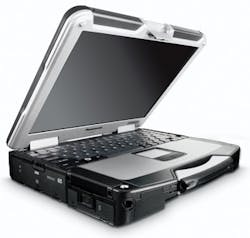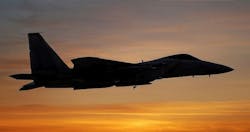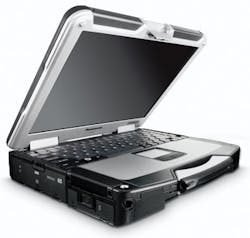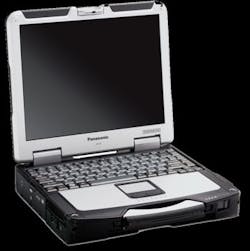Rugged, reliable laptops key in Air Force weather systems, alerting airmen to critical conditions
United States Air Force personnel carry out missions all over the globe in virtually every environment imaginable. With the mission of providing "compelling air, space, and cyber capabilities for use by the combatant commanders," it's essential to get the right information to the right person at the right time. To that end, tracking weather data in real time to advise airmen on potentially critical conditions is among the most important tasks toward ensuring safe, successful missions.
For the past 15 years, the U.S. Air Combat Command has relied on the AN/TMQ-53 Tactical Meteorological Observing System (TMOS) to accumulate and collect weather data accurately. The system was developed to address the Air Force's need for tactical, easily transportable meteorological systems. TMOS provides critical information to military personnel on air speed, wind direction, temperature, humidity, cloud height, and present weather conditions, such as rain, snow, fog, ice, and lightning.
"When we went into Afghanistan and Iraq and there were very few places that could provide accurate weather data, so these (TMOS) systems were deployed and subsequently turned into the Air Force's workhorse for weather data collection," says Barbara Moore, AN/TMQ-53 Program Manager.
When TMOS was first engineered, it was designed using standard, commercial off-the-shelf (COTS) consumer notebooks. While these consumer-grade notebooks had a lower sticker price, they quickly proved unreliable in the Air Force's challenging environment, ultimately costing more money in the end.
TMOS weather systems are deployed around the world — transported in boxes loaded into the back of a Humvee to deployment out of a helicopter. It is critical that all their technology components can function correctly during all types of deployments.
As TMOS was beginning to be used more heavily in Middle East combat zones, technical problems began to add up. Personnel reported that one of the highest failure rates of the systems were related to its computers. Some of the problems included sand intrusion, heat, and damage during transportation.
"Our airmen are now more combat-ready because they know when they test their Toughbook computers at the shop before they get on a plane to deploy, that the computer is also going to work in the deployed location" - Barbara Moore, AN/TMQ-53 Program Manager
"The systems get boxed up multiple times throughout the course of a deployment and get moved from rooftop to ground level, put in the back of Humvees and transported hundreds of miles into a helicopter," says Alli Bey, a contractor who helped to prepare the TMOS deployable weather systems. "The weather system can't operate or provide the user with any valuable information unless the computer can function correctly."
The consumer-grade devices were constantly failing in the field. While the computers would perform during an operational check before deployment, by the time the computers were deployed to the location, the devices would fail.
"It was a logistical nightmare to get computers all over the world in combat zones because hard drives were becoming loose, screens were being broken, or keyboards were clogged with sand," Bey explains.
In 2010, the Air Force was ready for a real solution. Bey and his team heard the failure complaints and decided to utilize rugged laptops instead. "The first product that came to mind was the Panasonic Toughbook," he adds. After looking at a few models, the team eventually settled on the Toughbook 30, the world’s most rugged laptop. Its powerful performance includes a MIL-STD-810G and IP65 certification as well as 18-hour battery life, ideal for all kinds of missions in every environment imaginable. Bey and his team worked with Panasonic to customize an ideal solution to meet their needs.
The U.S. Air Combat Command received the first Toughbook laptops in 2010 and deployed them to a combat weather team in Florida. "The team demoed them and quite frankly put them through hell to make sure that they were going to work – and all of them passed," Bey says. Following the testing process, the program was given permission to move forward in deploying Toughbook laptops and upgraded the entire fleet by the end of 2011. The deployment consisted of 342 TMOS tactical weather systems. The devices have been in use ever since, with only a handful of failures reported such as damaged port covers or drive problems.
"We were pretty excited when we got the first Toughbook and we were rough on it. We knocked it off a table, spilled sodas on it, we did everything we thought a deployed soldier could do and we were never able to cause one to fail," Bey describes. "Now the Air Force doesn't deploy without having the support of the TMOS which includes the Panasonic Toughbook. We love that it's modular and repairable at our level.
"During the Afghanistan war a forward operating base (FOB) took a director mortar hit. Thankfully no one was hurt but there was significant equipment damage. The Toughbook however, continued operate and collect data," Bey continues. "We knew we had a tough device." One of the things that attracted us to the Toughbook computers was that we could replace hard drives, screens, keyboards so we wouldn't necessarily have to throw away the entire laptop just because one piece is broken, Bey recalls. "In the last contract period we didn't execute any repairs because frankly none of them were breaking. The Toughbook computers have extended the life cycle for the TMOS systems and created a bigger value for the program by simply reducing the maintenance costs."
"Our airmen are now more combat-ready because they know when they test their Toughbook computers at the shop before they get on a plane to deploy, that the computer is also going to work in the deployed location," Moore says. Previously, it was up to the contractor to decide which computer to use and previous contractors chose to buy the cheapest computer that would fit the requirements. But now, the government mandates that the Air Force use Panasonic Toughbook 30 or Toughbook 31 computers or equivalents.
"The Toughbook laptops reduced the amount of inventory we had to keep on hand and decreased our shipping costs," Bey says. "We are no longer shipping computers all around the world because they are constantly failing. We went from a failure rate of about 25% of the entire fleet to down to less than two percent. That reduced our shipping costs by thousands. We were shipping an average of 50 computers a year, just to support computers that had failed and now we ship an average of two per year. Panasonic's rugged laptops have made us more efficient and combat ready, ensuring our airmen get the critical data they need when they need it."
Challenge - Solution - Result
The Air Force needed tactical, easily transportable meteorological systems to support their airmen. However, their current tactical weather systems, supported by consumer-grade mobile computers, were experiencing numerous failures. It was critical to find a reliable, rugged device to support the weather systems in combat zones and other missions around the world.
You might also like:
Subscribe today to receive all the latest aerospace technology and engineering news, delivered directly to your e-mail inbox twice a week (Tuesdays and Thursdays). Sign upfor your free subscription to the Intelligent Inbox e-newsletter at http://www.intelligent-aerospace.com/subscribe.html.
Connect with Intelligent Aerospace on social media: Twitter (@IntelligentAero), LinkedIn,Google+, and Instagram.



